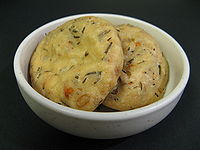
Ganmodoki
Encyclopedia

Tofu
is a food made by coagulating soy milk and then pressing the resulting curds into soft white blocks. It is part of East Asian and Southeast Asian cuisine such as Chinese, Japanese, Korean, Indonesian, Vietnamese, and others. There are many different varieties of tofu, including fresh tofu and tofu...
fritter
Fritter
A fritter is any kind of food coated in batter and deep fried. Although very similar to a doughnut it differs in the fact that it requires some base ingredient beyond the dough it is cooked with.-Anglo-American fritters:...
made with vegetables, egg white and sesame seeds. "Ganmodoki" means "pseudo-goose
Goose
The word goose is the English name for a group of waterfowl, belonging to the family Anatidae. This family also includes swans, most of which are larger than true geese, and ducks, which are smaller....
." This is because ganmodoki is said to taste like goose; compare mock turtle soup
Mock turtle soup
Mock turtle soup is an English soup that was created in the mid-18th century as a cheaper imitation of green turtle soup. It often uses brains and organ meats such as calf's head or a calf's foot to duplicate the texture and flavour of the original's turtle meat.Mrs. Fowle's Mock Turtle Soup,:"Take...
. "Ganmodoki" is also called "Ganmo" for short.
In the Kansai Region, Ganmodoki is called "hiryōzu", "hiryuzu" or "hirōsu", from the Portuguese word
Japanese words of Portuguese origin
Many Japanese words of Portuguese origin entered the Japanese language when Portuguese Jesuit priests introduced Christian ideas, Western science, technology and new products to the Japanese during the Muromachi period ....
"filhós
Filhós
Filhós is a traditional Christmas dessert in Portugal.Filhós are usually made by forming a ball from a mixture of flour, eggs, and pumpkin , which is optional. After the dough has risen, it is molded into a doughnut-like shape. Instead of having a hole in the center, like a doughnut, there is a...
." ("fried cake").


